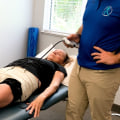The cons are that there are some contraindications (risks for people with pre-existing health problems) with this type of training and it can be painful.
BFR training
bands are only one or two inches wide, so they put pressure on a small area of the muscle. Its use is risky, there is simply too much room for error. Very little pressure and not worth much.If it's too tight, it can damage your nerves. Most BFR adaptations are to hypertrophy, not to maximum strength or power. Due to the nature of training, BFR will not help performance changes in tissue outside of small size changes. Although a review study found that athletes are potentially good candidates for BFR, I don't support this.
A healthy athlete has options, and when he can train without restrictions, the BFR brings little value.
Blood flow
restriction (BFR) training has become very popular among athletes and fitness professionals, as well as those with mobility impairments and those undergoing rehabilitation after injury or surgery. BFR training works by placing cuffs or bands around a limb of the body during exercise. The band or cuff helps maintain arterial flow to the muscle while preventing venous return.In other words, blood can flow to the muscles, but not come out of them. The disadvantage of bands is that they offer little consistency. It is extremely difficult to achieve any level of accuracy in various workouts because there is no way to apply a constant pressure level. Monday's training may seem very difficult, while Wednesday's training may seem too easy.
A bracelet, which has the ability to accurately measure a custom pressure, provides a much more consistent training method as well as greater safety to help reduce the risk of injury during training. The use of bands with varying amounts of restriction limits blood flow to the muscles that exercise, causing the body to think it is working harder. This may be referred to as blood flow restriction training, occlusion, or vascular reduction. Bands allow you to use a lighter weight than usual and achieve a higher repetition rate.
The most important benefit is the reduction of stress on the joints, a great advantage for anyone suffering from arthritis or recovering from injury.
Blood flow restriction
training is great for strengthening muscles around arthritic hips or knees, but without causing joint pain. This new form of bodyweight training increases strength and muscles, improves brain function, accelerates recovery from injury, improves energy generation and is low impact. Today we will explore this panacea of fitness, its pros and cons, the best bfr bands on the market and how you can start training for the best results.Blood flow restriction training is a safe and low-impact form of exercise suitable for injury rehabilitation, muscle building 26% strength, volume increase, workout recovery, cardiovascular fitness development and maintaining shape. It is especially effective in elderly and injured people, since they are often unable to perform intense exercise. I have come to respect the Blood Flow Restriction (BFR) training and I think it has value in certain situations. For those who are not familiar with the deformability of a red blood cell, it is basically about the flexibility of the membrane to move through small capillaries.
I mentioned an arm training circuit as an opportunity to get a pump that will please gym rats - some athletes like to train and this serves more as a pleasure than a recovery session. In fact, the number of properly designed studies showing the chronic effects of training with elite athletes in endurance or team sports is not available. I've learned that recovery training is rather an art by doing something now for future benefits, without expecting an acute benefit immediately outside of some changes in brain chemistry or responses to opiates. You can do blood flow restriction exercises at home or in the gym with convenient and affordable blood flow restriction bands.
I'm pretty convinced of the potential benefits, but since you're restricting blood flow, you obviously want to be smart about trying it yourself. Accurately measuring a custom pressure is important because it allows you to take the guesswork out of how much blood flow restriction you are applying to a limb individually. Despite the seemingly low risk of injury, if you're new to BFR, it's a good idea to ask a trainer or physical therapist who is trained in BFR techniques to teach you how it works. Since you can set your own pressure, occlusion training armbands are probably the best option if you want consistency and precision.
Wrapping an elastic band around the limbs at a specific pressure causes blood to “pool” in the muscle, unable to escape. . .



Leave Reply